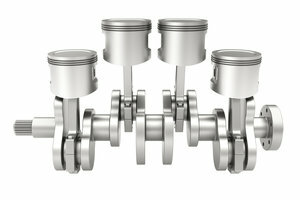Conversion of heat into mechanical energy
In your physics class you learned that every substance needs more heat to be heated to a certain temperature, the greater its mass. Although every amount of heat represents an amount of energy, it is not possible to completely convert heat into mechanical energy.

Conversion of heat into another type of energy
- If you study heat, you will learn that it is possible to completely convert a form of energy into heat. On the other hand, a conversion of heat into mechanical energy cannot be carried out in full. The reason for this lies in the nature of heat, which, according to the kinetic theory, is represented by the energy of the subordinate molecular motion.
- The theory assumes that when heat is applied to a body's molecules, energy is transferred. The warming causes the smallest particles to move faster from a random movement.
- As a result of this movement, the molecules have an energy, the total amount of which you describe as the internal energy of the substance in question. After the English explorer Brown, this movement is also called Brownian molecular movement.
- An amount of heat that is released when coal or oil is burned, for example, is initially contained in a high kinetic and potential energy of the molecules of the combustion gases. It is important for you that the speeds and directions of the molecular movement are randomly distributed.
- Note that due to the disorder of the molecules, the energy of these individual movements cannot be completely transferred to any neighboring solid body. It follows that the body as a whole moves and can do work.
- In order to convert as much of the heat as possible into mechanical work, it is transferred to a gas that is enclosed in a cylinder with moving pistons. You should take into account that on impact the molecules will only transfer part of their energy to the piston. Their speed decreases, which you can see as a decrease in temperature. To repeat the process, the cylinders must be returned to their starting position and the gas must be returned to the initial temperature.
Internal combustion engine efficiency - an explanation
The efficiency describes the value that a motor can use from the energy ...
Efficiency in converting heat into mechanical energy
- Already in the 19th In the 19th century, the French engineer Carnot was concerned with converting heat into mechanical energy and realized that part of the amount of heat absorbed at the initial temperature has to be released again as heat at the low final temperature. It cannot be converted into mechanical work. You should know that the higher the difference between the initial and final temperature, the greater the efficiency.
- The first piston steam engine designed by James Watt achieved an efficiency of only about two percent. It is interesting for you that, despite numerous improvements, the efficiency of these machines is not More than 18 percent could be increased, so that today no more plants with piston steam engines are built will.
- The most important steam-powered heat engine today is the steam turbine. The steam flows through the supply line and through a ring with adjustable regulating screws to the turbine wheels fitted with blades. These are set in rotation by the high-pressure steam flow.
- You should know that further guide vane rings and turbine wheels are arranged alternately behind the first turbine wheel in order to fully utilize the pressure of the steam. The blades get bigger and bigger because the water vapor expands with decreasing pressure.
- To reduce the heat losses in the boiler that arise when the heat is transferred from the combustion gases to the water vapor avoid, in 1867 Nikolaus August Otto built a gasoline engine in which a gasoline-air mixture burned in the cylinder itself will. As you can imagine, this increased the efficiency to more than 35 percent.
- In a diesel engine, air is first sucked in and very strongly compressed. As a result, the temperature rises above the ignition temperature of the fuel, so that it burns immediately after injection, without the need for ignition.
- Since the temperatures can rise to up to 2000 degrees Celsius and the pressures to 80 bar, a stronger construction of the diesel engine is necessary. Despite the higher manufacturing costs, you will always find this motor where a high degree of efficiency of up to 40 percent is required, such as in locomotives, trucks and Ships.
How helpful do you find this article?


